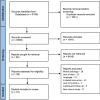Lower limb post-traumatic osteomyelitis: a systematic review of clinical outcomes
- PMID: 35986815
- PMCID: PMC10276112
- DOI: 10.1007/s00590-022-03364-2
Lower limb post-traumatic osteomyelitis: a systematic review of clinical outcomes
Abstract
Purpose: The aim of this study was to examine the patient-reported outcomes of patients presenting with post-traumatic osteomyelitis (PTOM) of the lower limb over the past 15 years. This period was chosen to reflect modern treatment principles and increased centralisation of care.
Methods: An electronic literature search of the relevant databases (PubMed, Ovid Medline, Embase, and the Cochrane library) was conducted to identify studies published between January 2006 and July 2021 reporting series of greater than 10 patients with PTOM of the tibia or femur at the site of a previous fracture. Studies reporting septic non-union were excluded.
Results: Sixteen eligible studies were identified and included in the final report. Remission of infection was achieved in 93.2% of cases (range 70-100%), whilst amputation was reported in 1-7% of cases. A variety of patient-reported outcome measures were utilised including the lower extremity functional scale, short musculoskeletal functional assessment, Enneking score, and EQ-5D-3L. Limb-specific functional outcomes returned to levels similar to that of the general population although poorer outcomes were noted in specific cohorts including those with complex anatomic disease and active medical comorbidities.
Conclusion: Infection following fracture fixation remains a difficult problem to treat. Regardless, using modern treatments and techniques patients can have comparable functional outcomes to that of the general population. High-quality studies are required to advance our knowledge into which types of treatments offer a benefit and how to further improve outcomes.
Keywords: Infection; Osteomyelitis; Outcomes.
© 2022. The Author(s).
Conflict of interest statement
All authors declare no conflict of interest.
References
Publication types
MeSH terms
LinkOut - more resources
Full Text Sources
Medical
Miscellaneous


